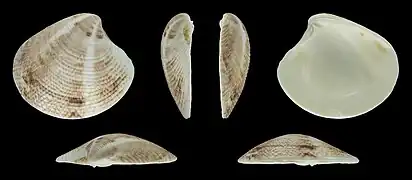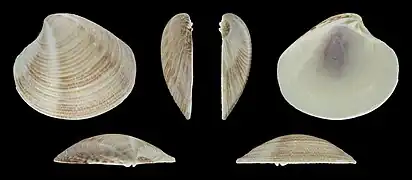| Chamelea gallina | |
|---|---|
 | |
| Scientific classification | |
| Domain: | Eukaryota |
| Kingdom: | Animalia |
| Phylum: | Mollusca |
| Class: | Bivalvia |
| Order: | Venerida |
| Superfamily: | Veneroidea |
| Family: | Veneridae |
| Genus: | Chamelea |
| Species: | C. gallina |
| Binomial name | |
| Chamelea gallina | |
| Synonyms[1] | |
| |
Chamelea gallina is a species of small saltwater clam, a marine bivalve in the family Veneridae, the venus clams.[2]
Taxonomy
Carl Linnaeus originally described Venus gallina from the Mediterranean Sea in 1758. It was not clear whether da Costa's 1778 Pectunculus striatulus was a different northern species or not.
Linnaeus afterwards mentioned that his V. gallina also occurs in Oceano Norvegico. In 1952, following Dodge, the name Chamelea gallina was considered to be valid. There were for a while two recognised subspecies: the Mediterranean C. g. gallina, and the Atlantic C. g. striatula.[1] However by 2016, the two subspecies were elevated to the species level, and listed separately on the database WoRMS.
Characteristics
The shell is solid and thick, with two equal sized valves and up to five centimetres long. It is broadly triangular but asymmetrical, having a round anterior margin but a somewhat elongated posterior. The periostracum is thin and the ligament connecting the two valves is narrow. The lunule is short and heart-shaped, light brown with fine radiating ridges. The shell is sculptured with about fifteen concentric ridges. The colour is whitish, cream or pale yellow, sometimes shiny, and usually with three red-brown radiating rays.[3]
 Right valve
Right valve Left valve
Left valve
Distribution
Chamelea gallina occurs on Eastern Atlantic coasts, from Norway and the British Isles, Portugal, Morocco, Madeira and the Canary Islands. It is also found in the Mediterranean Sea and the Black Sea and is abundant in the Adriatic Sea.[3]
Biology
Chamelea gallina lives under the surface of clean and muddy sand at a depth of between five and twenty metres. It is a filter feeder, taking in a variety of microalgae, bacteria and small particles of detritus.[3]
Uses
This species is used for food. In 1995 the total recorded catch was 42,000 tons with the largest catches being taken by Italy and Turkey. The shells are mostly caught with dredges but some bottom trawling is done and some aquaculture takes place in Italy.[3]
European law
The European Union regulament n° 1667/2006[4] has forbidden the commerce of clams having a length less than to 25 millimeters. The full list of the forbidden marine species is available as an annex of the Habitats Directive.
The new EU limit to the length of clams came into force in 2010. Two years later, the sanctions started to include a fine until a maximum of 4,000 euros,[5] besides to the seizure of the catch and the closure of the activity.[6]
The norm recalled a decree adopted by the Italian President Saragat in 1968[7][8] and created a severe economic damage for the Italian enterprises belonging to the ittic sector, characterized by a production of clams 22 millimeters long. That type of clam is an historic production of the Adriatic Sea mainly in Venice and Chioggia,[9] but also in Rimini and the Romagnole Coast[10]), and even in Campania due to the climate change and a new different mean saltiness of the Italian seas. which blocks the adult claim's growth at a diameter of around 22 mm.[5]
Against an intensive lobbying activity of the Spanish deputies at the European Parliament, in June 2016 the Italian parties reached a temporary triennal exception to the limit, in order to avoid the crisis of the ittic sector and to protect an Italian typical production.[11] On 9 October 2019, the exception was firstly delayed for another year[12] until 31 December 2020.[13] Italian organizations are pressing to the EU Parliament to concede a new dispensation form the limit of 25 millimeters.
References
- 1 2 Serge Gofas (2012). "Chamelea gallina (Linnaeus, 1758)". WoRMS. World Register of Marine Species. Retrieved February 14, 2012.
- ↑ Michelle Carter (2008). "Chamelea gallina. Striped venus clam". Marine Life Information Network: Biology and Sensitivity Key Information Sub-programme. Plymouth: Marine Biological Association of the United Kingdom. Retrieved February 14, 2012.
- 1 2 3 4 "Chamelea gallina (Linnaeus, 1758)". Species Fact Sheets. Fisheries and Aquaculture Department, Food and Agriculture Organization. Retrieved February 14, 2012.
- ↑ "Council Regulation n°1967/2006, concerning management measures for the sustainable exploitation of fishery resources in the Mediterranean Sea, amending Regulation (EEC) No 2847/93 and repealing Regulation (EC) No 1626/94". EUR-Lex. at article 3.
- 1 2 "Vongole italiane sotto misura secondo l'Ue. Poche raggiungono i 25 mm richiesti" (in Italian). July 17, 2015.
- ↑ "Ok Ue alla taglia minima per le vongole, salva la flotta" (in Italian). December 3, 2013.
- ↑ Zatterin, Marco (June 17, 2016). "L'Italia vince la battaglia delle vongole". La Stampa (in Italian).
- ↑ "Tesoro, mi si sono ristrette le vongole" (in Italian). February 6, 2016.
- ↑ Rosanna Conte (August 26, 2020). "Pesca delle vongole al di sotto dei limiti Ue, Bruxelles dà l'ok all'Italia" (in Italian).
- ↑ Alessandro Mazza (December 4, 2019). "Vongole, le misure contano. Via libera ai 25 mm, ma…".
- ↑ "L'Italia vince la battaglia delle vongole. Dal 2017 e per 3 anni si potranno pescare i molluschi bivalvi a partire da 22 mm" (in Italian). June 19, 2016. Retrieved October 17, 2020.
- ↑ "Vongole: Spagna contro Italia per la pesca di vongole inferiori ai 25 millimetri" (in Italian). October 10, 2019.
- ↑ "Vongole: Spagna contro Italia per la pesca di vongole inferiori ai 25 millimetri" (in Italian). October 9, 2019.
External links
- Habiats.org.uk, images